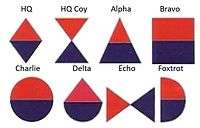Natal Field Artillery
The Natal Field Artillery / King Cetshawayo Artillery Regiment (usually abbreviated as NFA) is an artillery regiment of the South African Army. As a reserve unit, it has a status roughly equivalent to that of a British Army Reserve or United States Army National Guard unit. It is part of the South African Army Artillery Formation.
| Natal Field Artillery | |||
|---|---|---|---|
 SANDF Natal Field Artillery emblem | |||
| Active | September 1862 to present | ||
| Country | |||
| Allegiance | |||
| Branch | |||
| Type | Reserve artillery | ||
| Role | Medium (self propelled) Artillery (G6) | ||
| Part of | South African Army Artillery Formation Army Conventional Reserve | ||
| Garrison/HQ | Lord's Grounds, Durban 29°51′02″S 31°1′22″E | ||
| Motto(s) | Armis Arte Audacia (With Arms, Skill and Bravery) | ||
| Equipment | GV6 155 mm self-propelled howitzer | ||
| Engagements | Second Anglo-Boer War World War I World War II South African Border War | ||
| Battle honours |
| ||
| Commanders | |||
| Current commander | Major Craig Nel | ||
| Insignia | |||
| Collar Badge | Bursting grenade with seven flames | ||
| Beret Colour | Oxford Blue | ||
| Artillery Battery Emblems |  | ||
| Artillery Beret Bar circa 1992 |  | ||
History
Origin

The Natal Field Artillery was raised in 1862 as part of the Durban Volunteer Guard, and later became a unit in its own right.[1]
Operations
The regiment took part in numerous military actions, including:
- the Second Anglo-Boer War[2]
- the South African invasion of German South-West Africa during the First World War
- the Second World War, when the regiment formed part of the South African 2nd Infantry Division and was captured during the fall of Tobruk, part of the Western Desert Campaign in North Africa fighting Erwin Rommel. This occurred in a series of engagements called the Battle of Gazala. One of these engagements was Rommel's attack against Allied forces near Tobruk was on June 13, 1942. The 21st Panzer Division attacked South African positions on Rigel Ridge in the middle of a sandstorm. This was the 6th South African Anti-tank battery of the 2nd field regiment.[3] The South African gunners kept firing until all their guns were destroyed, allowing the withdrawal of other Allied formations.[4]:98 The guns were commanded individually and fired at the Panzers over open sights. The German tanks took up positions behind the ridge with anti-tank guns placed between them. The Germans put down a devastating fire onto the South African positions. One of the columns of Panzers attacked them from the rear, surrounding them and cutting off all escape. Nevertheless, the gunners kept firing until all eight guns had been destroyed. About half the gun detachments were killed and wounded, including the battery commander and many officers. When the battery had been silenced, the enemy tanks approached cautiously and the South African gunners were made prisoners. The entire Natal Field Artillery Regiment was captured and would not be re-formed until after the war.[5] On that day the Germans captured over 3,000 Allied prisoners.[6]:163
Other names
From 1913 to 1926, the NFA was designated the 7th Citizen Battery (NFA). From 1926 to 1932, it was the 2nd Citizen Battery (NFA). During the Second World War, it was the 2nd Field Regiment (NFA).
From 1960 to 1968, the regiment was affiliated to the University of Natal and was called the Natal University Regiment.
In August 2019, 52 units of the Reserve Force had their names changed to reflect the diversity of the current SANDF.[7] This unit had its name changed to the King Cetshwayo Artillery Regiment.
Affiliated division
Leadership
| From | Honorary Colonel | To |
| From | Commanding Officer | To |
| 1981 | Cmdt R. Lovell-Greene MMM JCD | 1989 |
| 27 June 2020 | Maj Craig Nel | Present |
| From | Regimental Sergeants Major | To |
| 27 June 2020 | MWO James Rumble | Present |
Regimental symbols
- Regimental motto: Armis Arte Audacia.
Insignia

Battle honours
Although artillery units in the South African Army do not usually receive battle honours, the NFA was awarded the honour
- South-West Africa 1915
Freedom of the City
The regiment was awarded the Freedom of Durban on 28 September 1962,[8] the Freedom of Pietermaritzburg on 29 September 1962 and the Freedom of eMnambithi / Ladysmith on 2 July 2011.[1]
References
- "Natal Field Artillery" (PDF). Reserve Force Division. South African Department of Defence. Retrieved 25 September 2014.
- "Natal Field Artillery". Anglo Boer War. Retrieved 18 January 2017.
- Tennant, Sir Iain. "Events in North Africa - June 1942". The Second World War Experience Center. Archived from the original on 6 February 2015. Retrieved 6 February 2015.
An extract from his memoirs
- Mitcham, S. (2007). Rommel's Lieutenants: The Men who Served the Desert Fox, France, 1940. Westport, Conn.: Praeger Security International. OCLC 237132754.
- "The South African Military History Society Newsletter". January 2012. Retrieved 6 February 2015.
- Greene, J; Massignani, A. (1994). Rommel's North Africa Campaign: September 1940-November 1942. Conshohocken, PA: Combined Books. OCLC 722092034.
- https://www.defenceweb.co.za/featured/new-reserve-force-unit-names/
- Gillings, Ken (6 September 2012). "Regiment has served the nation". Daily News. Independent Online. Retrieved 24 September 2014.